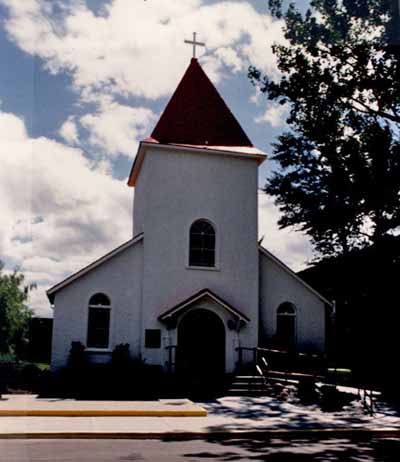Royal Canadian Mounted Police Depot, Chapel
Classified Federal Heritage Building
Regina, Saskatchewan

Front view
© Royal Canadian Mounted Police / Gendarmerie royale du Canada, 1986.
Address :
2 Dewdney Avenue, Royal Canadian Mounted Police (RCMP) Depot Division, Regina, Saskatchewan
Recognition Statute:
Treasury Board Policy on Management of Real Property
Designation Date:
1988-08-24
Dates:
-
1883 to 1883
(Construction)
Other Name(s):
-
The Chapel
(Other Name)
-
Building 13
(Other Name)
-
Chapel-Mess hall
(Other Name)
-
Former mess
(Other Name)
Custodian:
Royal Canadian Mounted Police
FHBRO Report Reference:
86-22
DFRP Number:
13735 00
Description of Historic Place
The Chapel, also known as Building 13 and the Chapel-Mess Hall, is located adjacent to the Barracks Square at the Royal Canadian Mounted Police (RCMP) Depot Division in Regina, Saskatchewan. It is a long, gable-roofed wooden structure with a steepled entry tower on its northern end. The plain exterior features an arched entrance on the main façade and regularly arranged tall, pointed windows. The designation is confined to the footprint of the building.
Heritage Value
The Chapel is a Classified Federal Heritage Building because of its historical associations, and its architectural and environmental values.
Historical Value
The Chapel is an exceptional example of a building strongly associated with the early presence of the RCMP in Regina (then known as the North West Mounted Police (NWMP)). Constructed as a mess hall in 1883 and converted into a chapel in 1895, it is the only structural reminder of the aggregation of wood-framed buildings erected to house the new Regina headquarters of the force in 1882-1883. As it is the oldest known building subsisting in Regina and a component of the oldest surviving mounted police facility, the Chapel remains one of the best examples illustrating the arrival of the NWMP in Regina, a turning point in the city’s history.
Architectural Value
The Chapel is valued for its good aesthetic qualities with a modest exterior that is complimented by a humble, unadorned interior. Good functional design is evident in its clear spatial organization and its continued use as a religious facility. The simple stained glass windows exhibit its very good craftsmanship and materials.
Environmental Value
The Chapel reinforces the present character of the Depot Division, as it is the only structure which relates directly to its founding. The prominently sited Chapel, facing directly into the Barracks Square, retained its historical relationship with its evolving military setting. Due to its unique function and its familiarity in the region, it symbolizes the RCMP Depot Division's wide national functional identity as the home and training centre of the RCMP.
Sources: I. Saunders, RCMP Building 13, Chapel-Mess, Regina, Saskatchewan, Federal Heritage Building Review Office Building Report 86-022; RCMP Building 13, Chapel-Mess, Regina, Saskatchewan, Heritage Character Statement, 86-022.
Character-Defining Elements
The character-defining elements of the Chapel should be respected.
Its good aesthetic and functional design, and very good craftsmanship and materials, as evidenced by:
- the small massing with a gable roof and a steepled tower on the north side; the regularly spaced fenestration; the centrally placed arched doorway on the main façade; its restored interior of humble appearance, notably its rustic wooden pews, its dedicated stained glass windows and the many memorial plaques dotting the walls.
The manner in which the Chapel reinforces the present character of RCMP Depot Division and is a symbol to the region, as evidenced by: its ongoing relationship to the Barracks Square and the surrounding landscape and plant materials (trees and shrubs); its prominent siting, most important since it is the only structure which relates directly to the founding of the Depot Division; its continued use as a religious institution; its familiarity to RCMP personnel, visitors and residents of Regina as a distinctive heritage landmark as.
Heritage Character Statement
Disclaimer -
The heritage character statement was developed by FHBRO to explain the reasons for the designation of a federal heritage building and what it is about the building that makes it significant (the heritage character). It is a key reference document for anyone involved in planning interventions to federal heritage buildings and is used by FHBRO in their review of interventions.
Building 13 was constructed as a mess hall in 1883 and converted into a chapel in 1895 after being damaged in a fire. The building was renovated in 1924, enlarged in 1939 and structurally upgraded in the late 1940s. The interior has been restored to the appearance of the original chapel. The chapel is a municipal heritage structure designated in 1983 because it is the oldest known building in Regina, and for its association with the arrival of the Mounted Police in Regina. An exclusively Anglican chapel until 1973, it continues in regular use today as an interdenominational facility. The building is the property of the RCMP. See FHBRO Building Report 88-22.
Reasons for Designation
The RCMP Chapel has been designated a Classified heritage building because of its strong historical association with the presence of the mounted police in Regina, because of its symbolic representation of a spiritual force which played a continuing role in the development of the institution and finally, on the basis of its role as a distinctive heritage landmark valued not only by the RCMP community at the national scale but also by the residents of Regina.
Character Defining Elements
The heritage character resides in the building as a whole. The progressive alterations, additions and improvements all contribute to the rich symbolic significance of the chapel. The restored interior, its humble appearance, its rustic wooden pews, its dedicated stained glass windows and the many memorial plaques dotting the walls, should be respected and preserved. Changes and alterations should be done in the spirit of the existing character.
The chapel's prominent siting is most important since it is the only structure which relates directly to the founding of the depot.
The relationship of the building to the barracks square, the landscape and the plant material (trees and shrubs) surrounding the chapel should be religiously maintained and preserved.